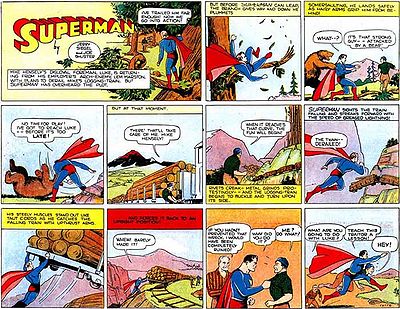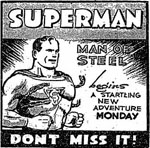
Superman (comic strip)
Encyclopedia

Superman
Superman is a fictional comic book superhero appearing in publications by DC Comics, widely considered to be an American cultural icon. Created by American writer Jerry Siegel and Canadian-born American artist Joe Shuster in 1932 while both were living in Cleveland, Ohio, and sold to Detective...
was a daily newspaper comic strip which began on January 16, 1939, and a separate Sunday strip was added on November 5, 1939. These strips ran continuously until May 1966. In 1941, the McClure Syndicate
McClure Syndicate
McClure Syndicate , the first American newspaper syndicate, introduced many American and British writers to the masses. Launched in 1884 by publisher Samuel S. McClure, it was the first successful company of its kind...
had placed the strip in hundreds of newspapers. At its peak, the strip was in over 300 daily newspapers and 90 Sunday papers, with a readership of over 20 million.
Original storylines
The daily strip was host to many storylines, unique from the regular Superman comic series. The early years consisted of Siegel-era Superman stories, many of which have yet to be republished. The strips contained the first appearance of a bald Lex LuthorLex Luthor
Lex Luthor is a fictional character, a supervillain who appears in comic books published by DC Comics, and the archenemy of Superman, although given his high status as a supervillain, he has also come into conflict with Batman and other superheroes in the DC Universe. Created by Jerry Siegel and...
, the first appearance of Mr. Mxyzptlk
Mister Mxyzptlk
Mr. Mxyzptlk , sometimes called Mxy, is a fictional impish supervillain who appears in DC Comics' Superman comic books.He was created by Jerry Siegel and Joe Shuster, and first appeared in Superman #30 . He is usually presented as a trickster, in the classical mythological sense, in that he enjoys...
and the first telephone booth costume change in comics. Other stories of note include Superman saving Santa Claus from the Nazis, WWII-era stories of Superman protecting the American home front and Clark Kent
Clark Kent
Clark Kent is a fictional character created by Jerry Siegel and Joe Shuster. Appearing regularly in stories published by DC Comics, he debuted in Action Comics #1 and serves as the civilian and secret identity of the superhero Superman....
marrying Lois Lane
Lois Lane
Lois Lane is a fictional character, the primary love interest of Superman in the comic books of DC Comics. Created by writer Jerry Siegel and artist Joe Shuster, she first appeared in Action Comics #1 ....
(and they lived together for years without her figuring out that he's Superman). The artwork, as mentioned above, includes runs by famed Superman artists Wayne Boring
Wayne Boring
Wayne Boring was an American comic book artist best known for his work on Superman from the late 1940s to 1950s. He occasionally used the pseudonym Jack Harmon....
and Curt Swan
Curt Swan
Douglas Curtis Swan was an American comic book artist. The artist most associated with Superman during the period fans and historians call the Silver Age of comic books, Swan produced hundreds of covers and stories from the 1950s through the 1980s.-Early life and career:Curt Swan, whose Swedish...
.
Superman appeared in the newspapers again in 1978, with the newspaper strip The World's Greatest Superheroes
The World's Greatest Superheroes
The World's Greatest Superheroes was a syndicated newspaper comic strip featuring DC Comics characters which ran Sunday and daily from April 9, 1978 to February 10, 1985...
, which lasted until 1985. Between these two comic strip series, Superman appeared in almost 12,000 unique newspaper strips.
Writers and artists

Joe Shuster
Joseph "Joe" Shuster was a Canadian-born American comic book artist. He was best known for co-creating the DC Comics character Superman, with writer Jerry Siegel, first published in Action Comics #1...
. As Superman became more and more popular and the workload kept increasing, Shuster turned over many duties to his studio assistants. Paul Cassidy was the first in a line of ghost artists on the strip and took over the inking and detail work in 1939. In September 1940, Leo Nowak replaced Cassidy on the strip. Other assistants during this time included Dennis Neville, John Sikela (beginning in 1940), Ed Dobrotka (beginning in 1941), Paul J. Lauretta, and Jack Burnley (beginning in 1941). Sikela and Dobrotka often traded penciling and inking duties between each other. Lauretta primarily inked and did backgrounds on the strips. Burnley eventually left to work on his own comic book Starman
Starman (comics)
Starman is a name used by several different fictional DC Comics superheroes, most prominently Ted Knight and his sons David and Jack.Created by writer Gardner Fox and artist Jack Burnley, the original Starman, Ted Knight, first appeared in Adventure Comics #61...
but did return to pencil the Superman Sundays in 1943. The Superman strips during this early period of shop work was a team effort with multiple artists working on different parts of the same strip.
This early period ended with the start of WWII. Jerry Siegel
Jerry Siegel
Jerome "Jerry" Siegel , who also used pseudonyms including Joe Carter, Jerry Ess, and Herbert S...
, the main writer, was drafted in 1943. Early that same year, Leo Nowak and John Sikela were drafted as well. In 1943, Stan Kaye took over the inking. Wayne Boring
Wayne Boring
Wayne Boring was an American comic book artist best known for his work on Superman from the late 1940s to 1950s. He occasionally used the pseudonym Jack Harmon....
, who had been another early assistant to Joe Shuster
Joe Shuster
Joseph "Joe" Shuster was a Canadian-born American comic book artist. He was best known for co-creating the DC Comics character Superman, with writer Jerry Siegel, first published in Action Comics #1...
, left the Shuster studio in 1942 to directly draw the daily strip for DC. Boring and Kaye dominated the daily strip’s artwork throughout most of the 1940s. The two also provided art for the Sunday strip between 1940 and 1966.
In the middle of 1949, Win Mortimer
Win Mortimer
James Winslow "Win" Mortimer was a comic book and comic strip artist best known as one of the major illustrators of the DC Comics superhero Superman...
took over the daily strip from Wayne Boring
Wayne Boring
Wayne Boring was an American comic book artist best known for his work on Superman from the late 1940s to 1950s. He occasionally used the pseudonym Jack Harmon....
. Stan Kaye continued inking Mortimer’s work until Kaye temporarily left, and Mortimer inked his own work until he left DC in 1956 to publish his David Crane strip. Curt Swan
Curt Swan
Douglas Curtis Swan was an American comic book artist. The artist most associated with Superman during the period fans and historians call the Silver Age of comic books, Swan produced hundreds of covers and stories from the 1950s through the 1980s.-Early life and career:Curt Swan, whose Swedish...
took over the daily strip on June 18, 1956, along with Stan Kaye. Swan continued on the strip until November 12, 1960.
As for the stories in the Superman strips, Jerry Siegel
Jerry Siegel
Jerome "Jerry" Siegel , who also used pseudonyms including Joe Carter, Jerry Ess, and Herbert S...
originally wrote them until he was drafted in 1943. Whitney Ellsworth, who had begun on the strip in 1941, continued until 1945. Jack Schiff began his writing on the strip in 1942 and worked on the strip off and on until 1962.
Alvin Schwartz first started writing for the Superman strip in October 1944. Between 1947 and 1951, Schwartz was the only writer on the Superman strip, and he continued on the strip until 1958.

Bill Finger
William "Bill" Finger was an American comic strip and comic book writer best known as the uncredited co-creator, with Bob Kane, of the DC Comics character Batman, as well as the co-architect of the series' development...
started scripting stories, and he worked through the series' end in 1966. During this final period, Jerry Siegel
Jerry Siegel
Jerome "Jerry" Siegel , who also used pseudonyms including Joe Carter, Jerry Ess, and Herbert S...
resumed his duties writing some stories.

